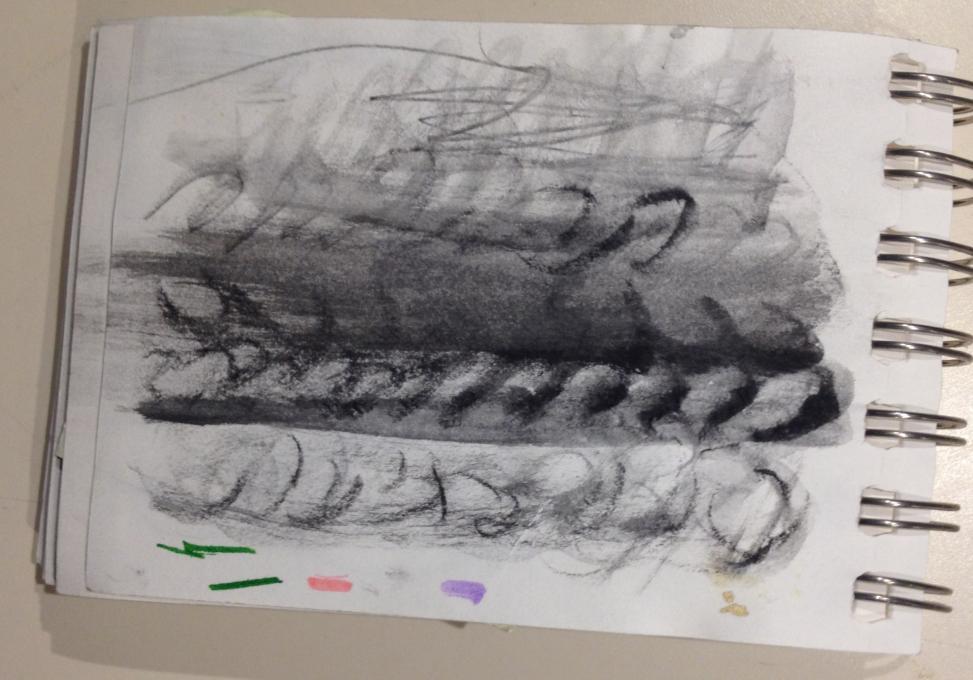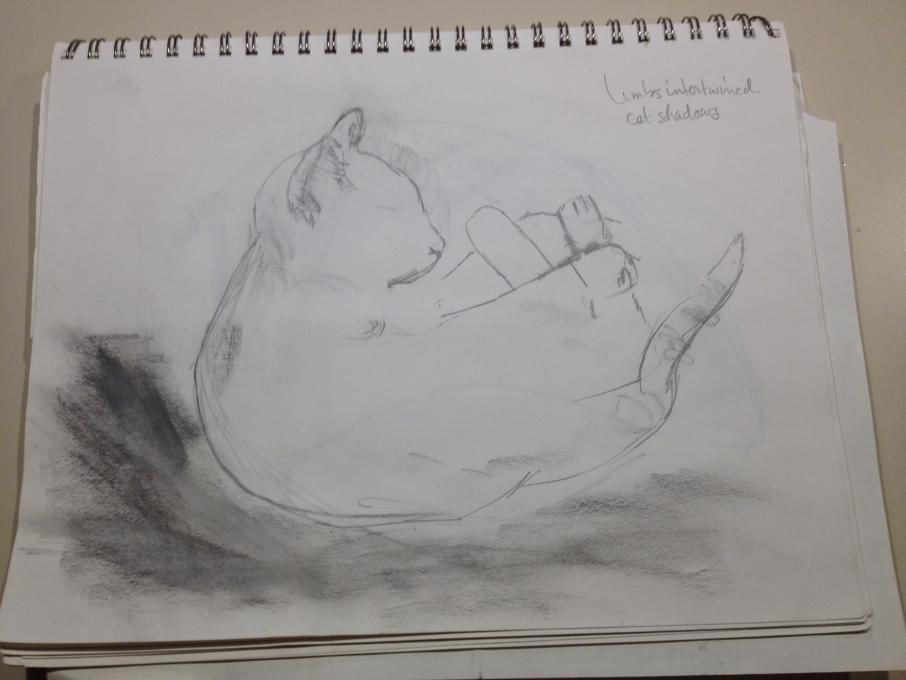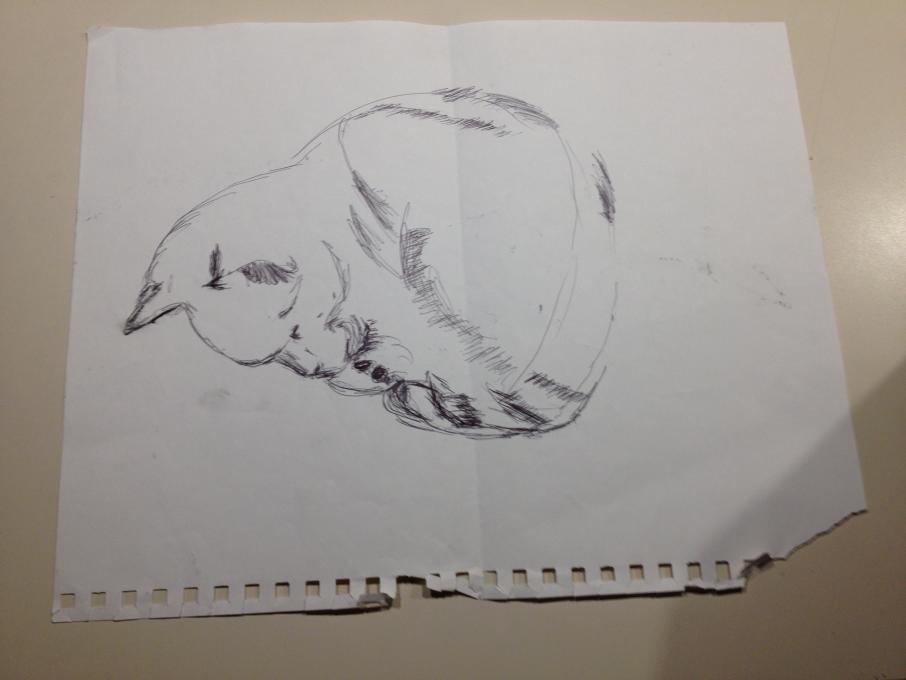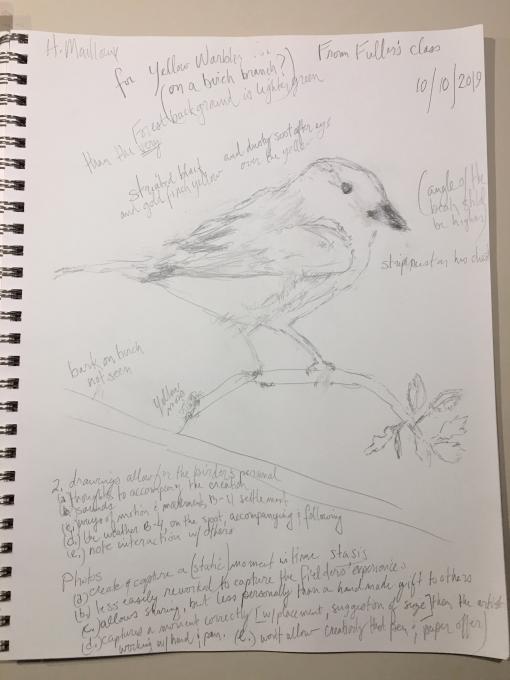holly
Forum Replies Created
Viewing 19 posts - 1 through 19 (of 19 total)
-
hollyParticipantI followed Fuller's course [and all the info her more experienced students offered], work as she suggested and have fun, be comfortable and not be too self critical. I've enjoyed what I gained, so far, but I've yet to complete the class. Since summer ends in central New England rather quickly, my perennials will survive. The last time I was able to sit outside with my sketch book and watch the birds enjoy that view I was able to do some planning for what was to come. Then the world [except for the birds I can feed in the winter] went wacky. Hollyin reply to: Illustrating the 3D World #788871
-
hollyParticipantEven fooling with lacy curtains helped in this class
 in reply to: Illustrating the 3D World #667883
in reply to: Illustrating the 3D World #667883 -
hollyParticipantI like the reminder from you and the other students in Fuller's class that, "...the habit formation process...can be resumed...". I'm famous for starting projects and not finishing them, but classes definitely help.in reply to: Style Your Journal Your Way #665409
-
hollyParticipantUsing a hand to close around your better eye [or have a small, packable telescope] instead of simply squinting for a your first, immediate view of your field object; or use one piece of paper you stash in the back of your journal with its center cut for you previously with a square or small round you can squint through.in reply to: Getting the Proportions Right #659556
-
hollyParticipant1. For years I've unknowingly been doing comparison studies [without having the terms to describe and enhanced knowledge of how to more properly sketch comparatively]. It was simply my curiosity to test the little I'd learned & my desire to make things better on my sketch pad. Using anchor points, her reminder to use what she already taught us about negative space and her willingness to use her ERASURE [as I made smudgy left-handed sketches] when we worked or were trying to clean things up on the pad will be always useful. 2, I've studied language & fancied myself a writer more than an artist, but after this class at Cornell I'm going to enjoy being both. With my memory problems [because of my epilepsy] Fuller's reminder to record dates, times & places my own sketch pad would make me a better secretary that the writer & artist could use.

 in reply to: The Power of Comparison #649808
in reply to: The Power of Comparison #649808 -
hollyParticipantWas anybody in the class a drafts person B-4 he or she became a interested in field sketching and journalism? I was taught about measuring proportions most simply using a pencil at arm's length or holding my thumb on my paintbrush at arm's length to make measurements and count. Another thing my first teacher suggested re: measure, focus & proportion was use two sheets of printer paper folded into perfect rectangles; from the folded tip , cut a 1"square from the center of one sheet & from the tip of the other cut a perfect 1"circle. This paper tool worked like the 'squint test ' Fuller asks us to use.
 in reply to: Getting the Proportions Right #649137
in reply to: Getting the Proportions Right #649137 -
hollyParticipantI have to agree it's good as a warm up. I bet you'll be great with anything Fuller offers usin reply to: Focusing on Your Subject – Blind Contour Drawing #648777
-
hollyParticipantBill, were you a draftsman before you got involved with nature and that pocket of your creativity?in reply to: Focusing on Your Subject – Blind Contour Drawing #648776
-
hollyParticipantIt was certainly an exercise to aid an older person to 'loosen up' and to remember first the size of my sketch pad . Everything I tried to draw rode off the edge of my pad, but Fuller's reminder to not be too hard on myself and just have fun made me giggle at my work in the end and determine to try to be a better student with any sparks to ones imagination she offers her students.in reply to: Focusing on Your Subject – Blind Contour Drawing #648775
-
hollyParticipantI like Prof. Fuller's suggestions to 'wanna be' field journalists and I will certainly find them useful. I will try to share more of the work I did PRE CORNELL & Fuller and hope she & others will give me the constructive criticism [which will be welcomed],but if I can get some my before and after work in the portfolio I'd appreciate an 'atta girl' if you all think its deserved.in reply to: Focusing on Your Subject – Blind Contour Drawing #648774
-
hollyParticipantI don't remember Prof.Fuller talking about the use of a hand lens B-4 and I'm curious [as I've not had the chance to look it up yet myself], but I can imagine what such a device might be. I think the 'pik glass' [a handheld tool, almost like what a jeweler uses] my dad gave me would serve the purpose. Hollyin reply to: Getting the Proportions Right #648773
-
hollyParticipant1. It's thirty years since I attempted two adult evening course [when I tried to learn about photography and about H2o painting]. I've always loved birds and growing up in central MA where my dad & I fed the birds all year round [and the squirrels when they robbed the hanging feeders]. I learned a great deal about gardening and its importance for the birds and the bees. I want to improve and stretch whatever skills I learned initially. A journal could solidify memories. 2. I've kept journals since I was a teenager. I never drew in any until after the evening art classes. Hearing Fullers other students speak and show on line their own journals reminded me more about my need to remember beautiful things I see, but can't trust my mind to remember. I was reminded also after looking at others field journals of something a grandmother always told me:"Always write the names & dates because you might not remember when you see them when you're older. 3. I like Fuller's positive attitude and encouraging ways to teach us all more. I'd remind people to never stop looking up!. You have to be able to hear in the field and look around. But look up to see shadows, spider webs or birds in thermals. When I was a soloed student sailplane pilot I learned to watch clouds for clues for areas to soar or look for the birds who thermal.in reply to: Style Your Journal Your Way #648117
-
hollyParticipantOnce again, share it if you’d like to. Do you think it helped you stay focused on your subject? Indeed it did! I discovered lots of things after this exercise. I can see clearly things I might not have noticed previously, like the effect of light and striations of my subjects things Prof. Fuller has taught us. My inability to judge distance and the amount of time I might need to complete any drawing are clearer after attempting this exercise and from the other things Prof. Fuller has taught us before using BLIND CONTOUR DRAWING. I'm not sure I cheated when I used my right hand as a ruler to simply keep my left hand on the page of my journal. It's a curious exercise and one I'll practice with. She's always so positive, but I was disappointed with myself. I won't give up though because the course is fascinating. I appreciate the work the other students are sharing and wish I'd taken art courses instead of language in college.in reply to: Focusing on Your Subject – Blind Contour Drawing #647216
-
hollyParticipantA comparison study is a very interesting way to manage and maintain my small garden properties. As October settles in central MA the plants and trees in my West Garden [almost all perennials] have gone to seed. Today I attempted to use Fuller's idea to contrast the one plant of Silvermound Wormwood I purchased and planted and the enormous quantity of 'Hens & Chicks' I received from a favorite aunt. They both seem to be spreading plants [I know the Hens & Chicks is]. I could see green, healthy looking portion of the Wormwood & on it's strongest stems there appeared to be bits of smaller , green. Before graying the leave, still feathery, turn yellow and start to curl. Hens & Chicks are VERY sturdy. The most tender of leaves remain green. The outer leaves are clearly seed hulls that release to open up the green within. I never saw it bloom, except except in my own garden. I have to look up whether a plant can be biennial. One can clearly see the flower stems all gray,brown then topple and reproduce spread & grow. Both plants have mounding ways of growing and make them pretty at the garden's edge. It's really difficult sketching as a left handed artisan. I use my eraser [and thankfully] keep a draftsman's brush in my basket. Without a doubt recording date, # of day and numerical data would help spark visions and make memories clearer Reply tin reply to: The Power of Comparison #646695
-
hollyParticipant
 I've used Prof. Fuller's idea to use a 'spot' to try for years to appreciate and capture the small portions of nature that are visitors or natives to my property. Sitting on the edge of my property I've worked with pencil & paper from my 'collapsible, sling over the back chair' and arrange what I saw, with what I was thinking and felt. in reply to: Opening Your Senses #646638
I've used Prof. Fuller's idea to use a 'spot' to try for years to appreciate and capture the small portions of nature that are visitors or natives to my property. Sitting on the edge of my property I've worked with pencil & paper from my 'collapsible, sling over the back chair' and arrange what I saw, with what I was thinking and felt. in reply to: Opening Your Senses #646638 -
hollyParticipantI want a journal to more properly remember the beautiful, odd things I see when I'm out and about, even if it's just on my small property. I don't always trust my mind to remember, but notations of any kind can help. A journal could be used as 'the spark' necessary to recreate and solidify that memory. I want to be able to return to it and ,with some assurance, subdue the hesitation and chaos I often feel. Ideas on paper might keep my mind sharper, share ideas I had with others. It might feel like pulling the curtains apart and aid me in seeing more clearly into my own memory. I believe Fuller's class will aid me in helping elementary things I learned years ago in the beginners drawing I accomplished. Learning from other students is something to look forward to here also. Muller's idea of zooming in and squaring details of drawing will be useful. Her interest in shadows and light is something all art students share. Nnuro jr's speed with pen and paint is something I wish I could gain. I'd remind everyone to 'DON'T FORGET to LOOK UP! The clouds are something I learned to watch carefully as a sailplane pilot. And I'd have missed a red-tailed hawk perched on a pole in my backyard if I'd not also been watching the clouds.in reply to: Style Your Journal Your Way #646473
-
hollyParticipantAmy, I'm impressed with your attention to angles [the bird's neck, head, beak, legs and its perch on the small branch]. However many art or ornithology courses you've taken, your work as a student of Prof. Fuller is paying offin reply to: Jump Right in! #646459
-
hollyParticipantHolly Mailloux My first attempt to post to Prof. Fuller's class and my answers to her questions.
 in reply to: Jump Right in! #646454
in reply to: Jump Right in! #646454 -
hollyParticipantI want a journal to more properly remember things I see when I'm out and about or from my deck watching birds at the feeders or my plants in my West Garden. I don't trust my mind to remember. A journal could be the spark necessary to solidifying those memories. I'd like to be able to return to it and with assurance, subdue the hesitation & chaos I often feel when looking at older, written journals of mine. To be aided with very elementary skills ought to be wonderful! It would be like pulling aside the curtains to let me see more clearly into my own memories. Muller's idea of zooming in & squaring details to her drawings is one I'd forgotten, but maintaining the squaring of the drawing [and zooming] to allow drawings to "pop" is one I like and will try to replicate. Her interest in shadow and light is one I share, but I'd suggest everyone to pasue and remember to LOOK UP. Alstom's exploration of color & shading is one I appreciate and I carry stubs of experiments I did at home is something I'd stick in my journal. I hope this class will aid me in matching what I saw as the speed Nnuro jr. works with pen and paint.in reply to: Style Your Journal Your Way #645779
Viewing 19 posts - 1 through 19 (of 19 total)




 I've used Prof. Fuller's idea to use a 'spot' to try for years to appreciate and capture the small portions of nature that are visitors or natives to my property. Sitting on the edge of my property I've worked with pencil & paper from my 'collapsible, sling over the back chair' and arrange what I saw, with what I was thinking and felt.
I've used Prof. Fuller's idea to use a 'spot' to try for years to appreciate and capture the small portions of nature that are visitors or natives to my property. Sitting on the edge of my property I've worked with pencil & paper from my 'collapsible, sling over the back chair' and arrange what I saw, with what I was thinking and felt. 